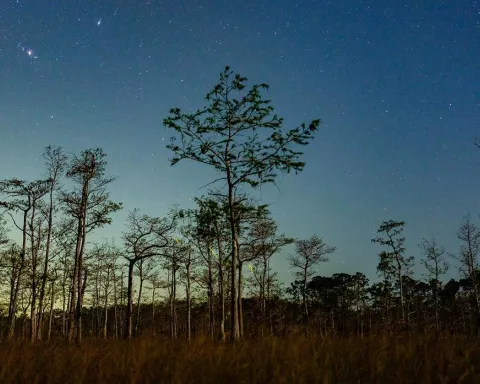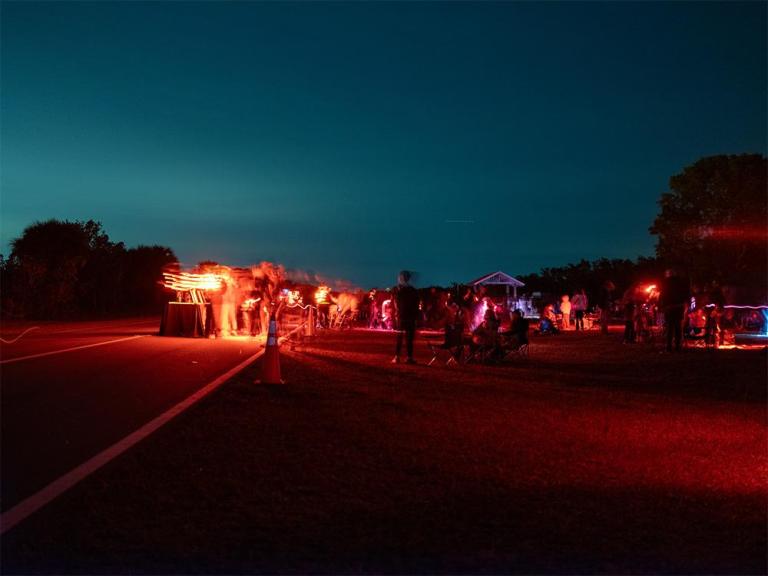The Best Stargazing Spots in Big Cypress National Preserve

Big Cypress National Preserve, located in southwestern Florida, is one of the best places in the entire state for stargazing. In fact, its vast expanses of wetlands and cypress forests work as a natural barrier against light pollution from nearby cities, meaning you can enjoy prime viewing conditions and even see the Milky Way without a telescope.
In 2016, Big Cypress received official recognition as an International Dark Sky Park, the first National Park Service site east of Colorado to do so. Whether you're an experienced astrophotographer or simply looking to catch the next celestial event, you can find a variety of incredible stargazing spots here—ranging from easy-to-reach locations to more remote settings. Keep reading to discover some of the best areas in Big Cypress National Preserve to consider for your next dark sky outing!

1. The Lawn at the Nathaniel P. Reed Visitor Center
To kick off our list of stargazing spots in Big Cypress, we highly recommend the lawn directly behind the Nathaniel P. Reed Visitor Center. After you park, walk to the southern end of Seagrape Drive, and you’ll find a grassy area where you can lay out a blanket and set up your chair, telescope, and camera gear (if you have it). It’s easy to reach and offers public bathrooms.
If you’re lucky enough to be visiting Big Cypress during the winter, you may even be able to join one of their signature ranger-led astronomy programs. These 45-minute talks take place about once a month from December to March and are free and open to the public. It’s best to arrive 30 minutes to an hour early to find a good spot to sit!
Please remember that pets are not allowed at the astronomy programs. All events are weather-dependent and may be moved inside the visitor center auditorium due to storms or cloudy skies. For any last-minute updates, check the preserve’s social media channels. After the program, you can interact with some of the local astronomy clubs, who oftentimes set up their own telescopes nearby.
2. Kirby Storter Roadside Park
You’ll come across Kirby Storter Roadside Park about halfway between Miami and Naples on Highway 41 through Big Cypress. While most people tend to stop here to walk the one-mile boardwalk trail, they may not realize it’s an excellent spot for a night of looking up to the sky.
Quick note: a recent fire has left the boardwalk trail inaccessible past the 0.3-mile mark. However, you can actually find some of the best stargazing near the trailhead/parking lot and the nearby roadside pull-off, where an open prairie provides a clear and unobstructed view. Plus, Kirby Storter Roadside Park has both picnic tables and restrooms, making it one of our top recommendations within the preserve.
3. Wagon Wheel Road
Wagon Wheel Road is part of a 17-mile loop drive that runs through the preserve—a great choice for those looking to get away from the more frequently visited areas. This gravel road branches off Turner River Road and stretches across the open wet prairie, far enough from the main highways and cities to avoid the effects of light pollution.
Because this area is more remote, you’ll likely encounter excellent stargazing conditions. However, you’ll also want to make sure to come prepared since there are no facilities nearby. Don’t forget to bring essentials like water, insect repellent, and a fully charged phone or GPS device.
4. Fire Prairie Trail
Located off a lesser-known access point within the preserve, Fire Prairie Trail is a bit of a hidden treasure. This trail leads through pine flatwoods and eventually opens up into a prairie area at the 0.75-mile mark, perfect for bringing a chair, telescope, camera, and tripod and taking in the stars.
Because it's relatively flat and open, there are few obstacles between you and the night sky. Just be aware that this is a more primitive area. For example, you won’t find bathrooms, lighting, or even cell signal in some spots. So, bring important items like a red flashlight, a GPS device, and, of course, a jacket or blanket in case the temperature drops after dark.
5. Loop Road
Loop Road is a 27-mile scenic byway that winds through the southern reaches of Big Cypress. During the day, nature lovers flock here to try to spot songbirds, barred owls, and alligators. Then, at night, it becomes one of the preserve’s best-kept secrets for stargazing.
There are several pull-off areas along the road where you can stop, get out, and take in the stars. Since the road is unpaved and conditions can vary depending on the season, we recommend checking with the ranger station before you start the drive. You’ll also want a reliable vehicle and a red flashlight to navigate after dark. The mix of cypress stands and open skies gives you a dynamic view of the stars that change as you move along the road.
Whether you decide to participate in one of the astronomy programs at the visitor center or explore more remote sections of the preserve, Big Cypress is the perfect place to experience a truly dark night sky. From wide-open prairies to secluded scenic drives, you have the chance to see a side of nature that not everyone gets to see. For stargazing that’s truly out of this world, ONLY Paradise will do.